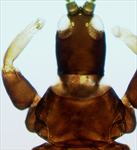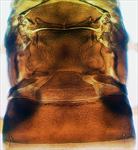
Short-winged female

Antenna

Head & pronotum

Mesonotum, metanotum, pelta & tergite II

Tergites IX–X (tube)
Both sexes either fully winged or with wings shorter than thorax width. Body, legs and antennae brown, fore tarsi and antennal segment III sometimes paler; fore wing weakly shaded. Antennae 8-segmented; segments III & IV with apex truncate, 2 sense cones on III, 4 on IV; segment VIII slender. Head longer than wide, without sculpture dorsally; eyes much larger dorsally than ventrally; postocular setae wide apart, apices blunt; maxillary stylets retracted to postocular setae, one third of head width apart with slender maxillary bridge. Pronotum with no sculpture medially; anteromarginal setae minute; remaining 4 pairs of major setae unstable in size and shape, long or very short; paired prosternal basantra present. Fore tarsus with small hooked tooth at inner apex. Metanotum reticulate. Fore wings parallel sided, without duplicated cilia. Pelta reticulate; tergites II & VII with wing retaining setae weak, sigmoid on III–VI; tergite IX setae S1 bluntly pointed, about as long as tube.
Male smaller, tergite IX setae S2 short and stout; sternite VIII with broadly transverse pore plate.
The genus Amynothrips includes only one species. Although this has prosternal basantra similar to those found in Haplothrips and its relatives, the fore wing is parallel sided not constricted medially.
Breeding on the leaves of Alligator weed, Alternanthera philoxeroides [Amaranthaceae], of which aquatic weed it is a useful biological control agent (O'Neill, 1968).
Native to Argentina, Brazil, Paraguay, and Uruguay, but introduced to USA and Australia (Mound & Marullo, 1996).
PHLAEOTHRIPIDAE, PHLAEOTHRIPINAE
Amynothrips andersoni O'Neill
Amynothrips andersoni O'Neill, 1968: 179
Mound LA & Marullo R (1996) The Thrips of Central and South America: An Introduction. Memoirs on Entomology, International 6: 1–488.
O'Neill K (1968) Amynothrips andersoni, a new genus and species injurious to alligatorweed (Thysanoptera: Phlaeothripidae). Proceedings of the Entomological Society of Washington 70 (2): 175–183.